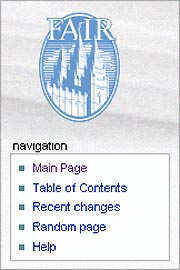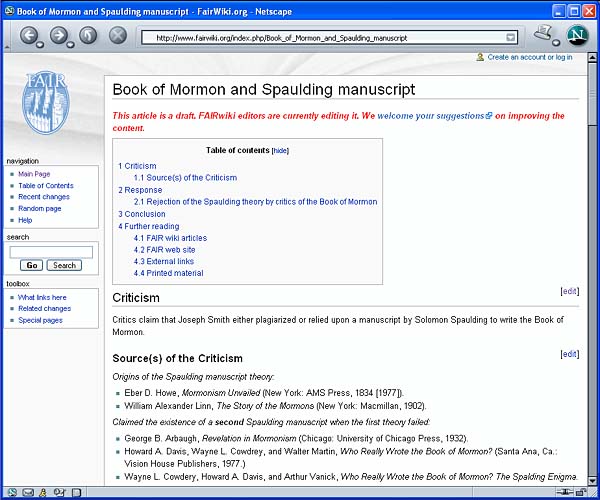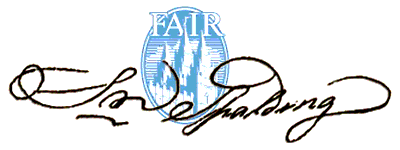

|
Document: 2006 FAIRwiki Spalding Page Source: http://www.fairwiki.org/index.php/Book_of_Mormon_and_Spaulding_manuscript Introduction Contents Criticism Response Conclusion Comments: |
Cowdrey, et al.: Who Really Wrote... (1977) The Spalding Enigma (2000)
Response to R. & R. Brown | Response to Matthew Brown | Dr. Criddle's paper
No copyright notice was posted for this FAIRwiki web-page
when accessed at its URL on August 18, 2006

(click here for August 18, 2006 FAIRwiki web-page screen-shot)
|
Book of Mormon and Spaulding manuscript This article is a draft. FAIRwiki editors are currently editing it. We welcome your suggestions (http://fairlds.org/contact.php) on improving the content. Table of contents 1 Criticism 1.1 Source(s) of the Criticism 2 Response 2.1 Rejection of the Spaulding theory by critics of the Book of Mormon 3 Conclusion 4 Further reading 4.1 FAIR wiki articles 4.2 FAIR web site 4.3 External links 4.4 Printed material |
|
Criticism Critics claim that Joseph Smith either plagiarized or relied upon a manuscript by Solomon Spaulding to write the Book of Mormon. Source(s) of the Criticism Origins of the Spaulding manuscript theory: • William Alexander Linn, The Story of the Mormons (New York: Macmillan, 1902). Claimed the existence of a second Spaulding manuscript when the first theory failed: • Howard A. Davis, Wayne L. Cowdrey, and Walter Martin, Who Really Wrote the Book of Mormon? (Santa Ana, Ca.: Vision House Publishers, 1977.) • Wayne L. Cowdery, Howard A. Davis, and Arthur Vanick, Who Really Wrote the Book of Mormon? The Spalding Enigma. (St. Louis: Concordia, 2005.) |
|
Response Since the Book of Mormon was first published, many have been unwilling to accept Joseph Smith's account of how it was produced. It's easy to dismiss Joseph's story of angels, gold plates, and a miraculous interpretation process; it's much harder to come up with an alternative explanation that accounts for the complexity and consistency of the Book of Mormon, as well as the historical details of its production. Many critics, unwilling to credit the uneducated, backwater farm boy Joseph Smith as the Book of Mormon's author, have looked to possible sources from which he could have plagiarized. One of the earliest theories was that Joseph plagiarized the unpublished manuscript of a novel written by the Reverend Solomon Spaulding (1761–1816). Spaulding was a lapsed Calvinist clergyman and author of an epic tale of the ancient Native American "Mound Builders." The theory postulates that Spaulding wrote his manuscript in biblical phraseology and read it to many of his friends. He subsequently took the manuscript to Pittsburg, where it fell into the hands of a Mr. Patterson, in whose office Sidney Rigdon worked, and that through Sidney Rigdon it came into the possession of Joseph Smith and was made the basis of the Book of Mormon. There are two major problems with this theory: 2. The purported Spaulding manuscript was not brought forward for analysis because no one knew where it was, or if it even existed. In 1884 an authentic Solomon Spalding manuscript was recovered in Honolulu, Hawaii and taken to the Oberlin College Library in Ohio. The unfinished story bore hardly any resemblance to the Book of Mormon. The text was published by the RLDS Church in 1885 under the title "Manuscript Found." The LDS Church also published the text. (See "Further Reading," below, for links to online texts). The discovery and publishing of the manuscript put to rest the Spaulding theory for several decades. But in the early 20th century the theory surfaced again, only this time its advocates claimed there was a second Spaulding manuscript that was the real source for the Book of Mormon. However, supporters of the revised Spaulding theory have not produced this second purported manuscript. Rejection of the Spaulding theory by critics of the Book of Mormon Many critics of the Book of Mormon reject the Spaulding theory as unworkable: [This theory is] "erroneous, and it will lead to almost certain defeat.... The facts are all opposed to this view, and the defenders of the Mormon dogma have the facts well in hand.... The Spaulding story is a failure. Do not attempt to rely upon it — it will let you down." • Fawn Brodie, No Man Knows My History (New York, A. A. Knopf, 1945). • Jerald and Sandra Tanner, Did Spaulding Write the Book of Mormon? (Salt Lake City: Utah Lighthouse Ministry, 1977). |
|
Conclusion Modern supporters of the Spaulding authorship theory simply ignore the inconvenient fact that the manuscript recovered in the late 19th century bears no resemblance to the Book of Mormon and that no second manuscript has been discovered. Until the purported second manuscript appears, all these critics have is a nonexistent document which they can claim says anything they want. This is doubtlessly the attraction of the "theory" and shows the lengths to which critics will go to disprove the Book of Mormon. It is interesting to consider that the best explanation such critics can propose requires that they invent a document, then invent its contents. |
|
Further reading FAIR wiki articles • Automatic writing • Epilepsy • The Golden Pot • Joseph Smith as "author and proprietor" • Joseph Smith, Sr.'s dream and Lehi's vision • Plagiarized from the Bible • The Spaulding manuscript [this page] • View of the Hebrews • Wordprint studies FAIR web site • Matthew B. Brown, "Solomon Spaulding and the Book of Mormon" • Daniel C. Peterson, "The Divine Source of the Book of Mormon in the Face of Alternative Theories Advocated by LDS Critics" • John K. Wise, "Clouds Without Water, Zeal Without Knowledge" External links • Bruce D. Blumell, "Would you respond to the theories that the Book of Mormon is based on the Spaulding manuscript or on Ethan Smith's View of the Hebrews?," Ensign (September 1976): 83–87. off-site • Lester Bush, "The Spalding [sic] Theory Then and Now," Dialogue: A Journal of Mormon Thought 10:4 (Autumn 1977): 40–69. off-site • Orson Scott Card, "News of the Church: Spaulding Again?," Ensign (September 1977): 94–95. off-site • Jeff Lindsay, "Plagiarism in the Book of Mormon: Is It Derived from Modern Writings?, jefflindsay.com (accessed 5 October 2005). off-site • L. Ara Norwood, "Book of Mormon Authorship: A Closer Look (Review of Book of Mormon Authorship: A Closer Look by Vernal Holley)," FARMS Review of Books 1/1 (1989): 80–88. off-site • Gary F. Novak, "Naturalistic Assumptions and the Book of Mormon," Brigham Young University Studies 30:3 (1990): 23–40. off-site • "Origins of the Spaulding Manuscript", by Professor A. S. Root, Oberlin College, 12 May 1927. off-site • Matthew Roper, "The Mythical "Manuscript Found" (Review of: Who Really Wrote the Book of Mormon? The Spalding Enigma)," FARMS Review 17/2 (2005): 7–140. off-site PDF link GL direct link • President Joseph F. Smith, "The Manuscript Found," Improvement Era (February 1900): ? page. GospeLink off-site Printed material Over the years many Latter-day Saints have responded to the "Spaulding Theory" as well. • B.H. Roberts, "A Brief Debate on the Book of Mormon," Defence of the Faith and the Saints, Vol. 1, (Salt Lake City: Deseret News, 1907), 365. GL direct link • B.H. Roberts, "The Origin of the Book of Mormon," Defence of the Faith and the Saints, Vol. 2, (Salt Lake City: Deseret News, 1907), 95–229 GL direct link • Benjamin Winchester, The Origin of the Spaulding Story, Concerning the Manuscript Found, (Philadelphia: Brown, Bicking & Guilfert, 1840). • Dean C. Jessee, 'Spalding theory' re-examined,' Church News (20 August 1977): 3–5. |
|
FAIRwiki Spalding Authorship Claims Web-Page 
(under construction) |
Return to Top of Page
Spalding Studies | New Spalding Library | Old Spalding Library
Mormon Classics Cowdery Bookshelf Old Newspapers History Vault
Last Revised: Oct. 19, 2005